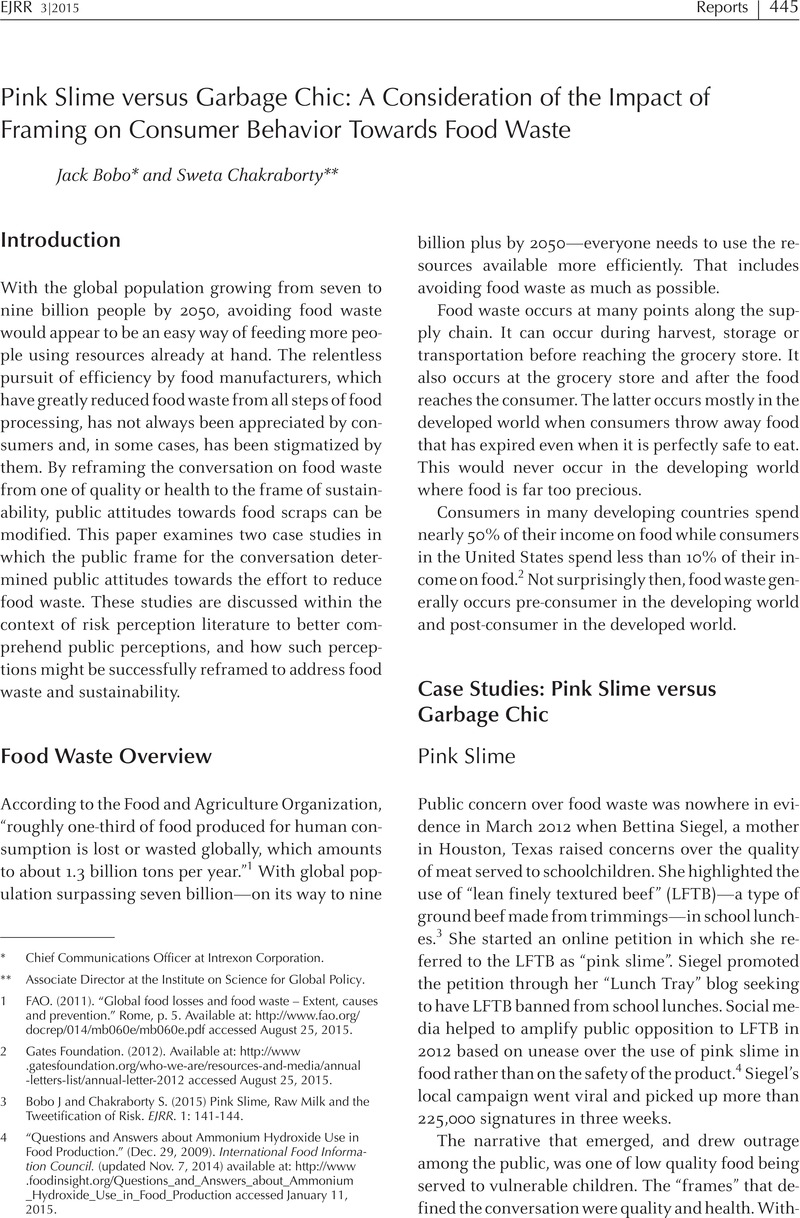No CrossRef data available.
Article contents
Pink Slime versus Garbage Chic: A Consideration of the Impact of Framing on Consumer Behavior Towards Food Waste
Published online by Cambridge University Press: 20 January 2017
Abstract

- Type
- Reports
- Information
- Copyright
- Copyright © Cambridge University Press 2015
References
1 FAO. (2011). “Global food losses and food waste – Extent, causes and prevention.” Rome, p. 5. Available at: http://www.fao.org/docrep/014/mb060e/mb060e.pdf accessed August 25, 2015.
2 Gates Foundation. (2012). Available at: http://www.gatesfoundation.org/who-we-are/resources-and-media/annual-letters-list/annual-letter-2012 accessed August 25, 2015.
3 Bobo, J and Chakraborty, S. (2015) Pink Slime, Raw Milk and the Tweetification of Risk. EJRR. 1: 141–144.Google Scholar
4 “Questions and Answers about Ammonium Hydroxide Use in Food Production.” (Dec. 29, 2009). International Food Information Council. (updated Nov. 7, 2014) available at: http://www.foodinsight.org/Questions_and_Answers_about_Ammonium_Hydroxide_Use_in_Food_Production accessed January 11, 2015.
5 Schlachter, B. (April 14, 2012). “A Texas mom's fight against ‘pink slime.’” Star–Telegram. Available at: http://www.star-telegram.com/living/family/moms/article3831060.html accessed January 11, 2015.
6 “With Dan Barber's Dumpster Dive Experiment, Table Scraps Get Celebrity Chef Treatment.” (April 1, 2015). Fast Company. Available at: http://webnesday.com/with-dan-barbers-dumpster-dive-experiment-table-scraps-get-celebrity-chef-treatment/ accessed August 25, 2015.
7 Spiegel, A. (Mar. 27. 2015). “Blue Hill's ‘WastED’ Pop-Up Restaurant Shows How Appetizing Food Waste Can Be.” Huffington Post. Available at: http://www.huffingtonpost.com/2015/03/27/blue-hill-wasted-pop-up_n_6949058.html accessed August 25, 2015.
8 Shin, Nara. (Mar. 18, 2015). “Fine dining with food scraps at wastED.” Cool Hunting. Available at: http://www.coolhunting.com/food-drink/fine-dining-with-food-scraps-wasted-nyc-blue-hill-dan-barber accessed August 25, 2015.
9 Kiesel, K., McCluskey, J.J., & Villas–Boas, S.B. (2011). “Nutritional labeling and consumer choices.” Annual Review of Resource Economics, 3, 17.1-17.18.CrossRefGoogle Scholar
10 Thaler, R.H., & Sunstein, C.R. (2008). Nudge: Improving decisions about health, wealth, and happiness. New Haven, CT: Yale University Press.Google Scholar
11 Vallone, R.P., Ross, L., and Lepper, M.R. (1985). “The hostile media phenomenon: Biased perception and perceptions of media bias in coverage of the Beirut massacre.” Journal of Personality and Social Psychology. 49, 577–585.CrossRefGoogle ScholarPubMed
12 Lynch, J.G. Jr., & Srull, T.K. (1982). “Memory and attentional factors in consumer choice: Concepts and research methods.” Journal of Consumer Research, 9(1), 18–37.CrossRefGoogle Scholar
13 Kahneman, D., & Tversky, A. (1984). “Choices, values, and frames.” American Psychologist, 39, 341–50.CrossRefGoogle Scholar
14 Tversky, A. and Kahneman, D. (1973). “Availability: A heuristic for judging frequency and probability.” Cognitive Psychology. CrossRefGoogle Scholar
15 Velez–Mitchell, Jane (March 7, 2012). CNN.com. Available at: http://edition.cnn.com/TRANSCRIPTS/1203/07/ijvm.01.html Accessed Aug. 17th, 2015.
16 Slovic, P. (1987) “Perception of risk,” Science, Vol. 236, No. 4799, pp. 280–285 CrossRefGoogle ScholarPubMed.
17 Spiegel, A. (Mar. 27. 2015). “Blue Hill's ‘WastED’ Pop-Up Restaurant Shows How Appetizing Food Waste Can Be.” Huffington Post. Available at: http://www.huffingtonpost.com/2015/03/27/blue-hill-wasted-pop-up_n_6949058.html, accessed August 25, 2015.


